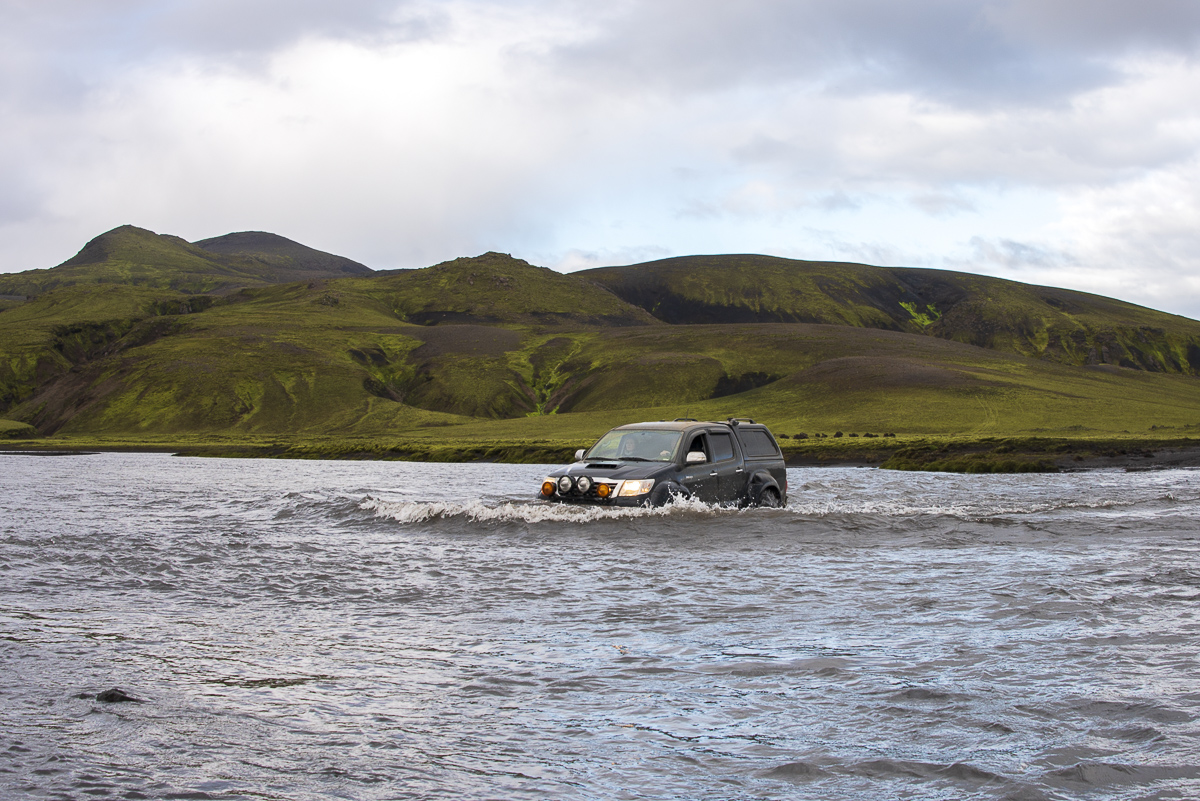|
Kaldadalsvegur
The Kaldadalsvegur (, ) is the shortest of the highland tracks traversing the Highlands of Iceland, therefore the nickname "highlands for beginners" . Its name derives from the valley it crosses: ''Kaldidalur'' means "cold dale/valley". Sometimes the Kaldadalsvegur is referred to as simply "the Kaldidalur". The route begins a bit to the north of Þingvellir and to the west of the volcano Skjaldbreiður, which really comes up to its name (meaning ''broad shield''). The track continues between the glaciers Þórisjökull and Ok and leads up to the north. To the east of Reykholt it comes near the ''Reykholtsdalur'' to Húsafell. Then it continues up to ''Hvammstangi'' at the ''Miðfjörður''. Signed as route 550 (formerly F550), the track is 40 kilometers long, and has no unbridged river crossings. (The Kaldadalsvegur is ''not'' an F road, and a four-wheel-drive vehicle is ''not'' legally required to traverse it, however many car rental companies forbid the use of their two ... [...More Info...] [...Related Items...] OR: [Wikipedia] [Google] [Baidu] |
Roads In Iceland
This article covers road transportation in Iceland. History As late as 1900 Iceland had only a few miles of roading suitable for wheeled transport, mostly located in the southern regions of the island. A network of bridle paths permitted travel and transport elsewhere. In 1884 a Norwegian expert was brought in to organise the construction of proper roads. Beginning in 1888 a series of iron bridges were constructed to cross major rivers.Page 231, Volume 14, The Encyclopaedia Britannica, Eleventh Edition In 1894 a Road Act was passed classifying Icelandic roads into four categories. The first were "High Roads" (also called "National Roads") that were entirely funded by the state. The second were "Provincial Roads" that were funded by the provinces except where they were could be used for carriage-transport, in which case there were subsidised by the state for up to half their cost. The third category was that of "Parish Roads" which were of local importance and funded by individua ... [...More Info...] [...Related Items...] OR: [Wikipedia] [Google] [Baidu] |
Highlands Of Iceland
The Highland (Icelandic language, Icelandic: ''Hálendið)'' or The Central Highland is an area that comprises much of the interior land of Iceland. The Highland is situated above and is mostly uninhabitable. The soil is primarily volcanic ash, and the terrain consists of basalt mountains and lava fields. Snow covers the Highland from October until the beginning of June. A few oasis-like areas, such as Herðubreiðarlindir and Thórsmörk, Þórsmörk, are also found in the Highland. The area has many notable natural features and hiking trails. Natural features in the Highland The Highland encompasses various geological features, including Landmannalaugar, Torfajökull, Eldgjá, Thórsmörk, Þórsmörk, Herðubreið, Askja, Hveradalir, Laki, Lakagígar, and the Fagrifoss waterfall. Sites in the Highland are difficult to access and may be accessible only during the summer months. Most sites require all-wheel drive or all-terrain vehicles for access due to the unpaved dirt ro ... [...More Info...] [...Related Items...] OR: [Wikipedia] [Google] [Baidu] |
Þingvellir
Þingvellir (, anglicised as ThingvellirThe spelling ''Pingvellir'' is sometimes seen, although the letter "p" is unrelated to the letter thorn (letter), "þ" (thorn), which is pronounced as "th".) was the site of the Althing, Alþing, the annual parliament of Iceland from the year 930 until the last session held at in 1798. Since 1881, the parliament has been located within Alþingishúsið in Reykjavík. is now a national park in the municipality of in southwestern Iceland, about 40 km (25 miles) northeast of Iceland's capital, . is a site of historical, cultural, and geological significance, and is one of the most popular tourist destinations in Iceland. The park lies in a rift valley that marks the crest of the Mid-Atlantic Ridge and the boundary between the North American Plate, North American and Eurasian Plate, Eurasian tectonic plates. To its south lies , the largest natural lake in Iceland. National Park ( ) was founded in 1930, marking the 1000th anniversary o ... [...More Info...] [...Related Items...] OR: [Wikipedia] [Google] [Baidu] |
Volcano
A volcano is commonly defined as a vent or fissure in the crust of a planetary-mass object, such as Earth, that allows hot lava, volcanic ash, and gases to escape from a magma chamber below the surface. On Earth, volcanoes are most often found where tectonic plates are diverging or converging, and because most of Earth's plate boundaries are underwater, most volcanoes are found underwater. For example, a mid-ocean ridge, such as the Mid-Atlantic Ridge, has volcanoes caused by divergent tectonic plates whereas the Pacific Ring of Fire has volcanoes caused by convergent tectonic plates. Volcanoes resulting from divergent tectonic activity are usually non-explosive whereas those resulting from convergent tectonic activity cause violent eruptions."Mid-ocean ridge tectonics, volcanism and geomorphology." Geology 26, no. 455 (2001): 458. https://macdonald.faculty.geol.ucsb.edu/papers/Macdonald%20Mid-Ocean%20Ridge%20Tectonics.pdf Volcanoes can also form where there is str ... [...More Info...] [...Related Items...] OR: [Wikipedia] [Google] [Baidu] |
Skjaldbreiður
Skjaldbreiður (, "broad shield") is an Icelandic lava shield formed in a huge and quite protracted eruption series from about roughly 9,500 years ago. The extensive lava fields which were produced by this eruption, flowed southwards, and formed the basin of Þingvallavatn, Iceland's largest lake, and Þingvellir, the "Parliament Plains" where the Icelandic national assembly, the Alþing was founded in 930. The volcano summit is at , and its crater measures roughly in diameter. The Skjaldbreiður lava shield covers with a volume of about . and is sometimes considered as a separate southern part of the Oddnýjarhnjúkur-Langjökull volcanic system which it is usually classified as being within. In this context its most recent eruption would be 3600 years ago, and the earliest eruption after the last ice age 10,200 years ago. There are at least three lava units deposited between 6000 and 9000 years BP, Straddling the Mid-Atlantic Ridge The Mid-Atlantic Ridge is a mid ... [...More Info...] [...Related Items...] OR: [Wikipedia] [Google] [Baidu] |
Þórisjökull
Þórisjökull or Thórisjökull (, Icelandic for "Thóris's glacier") is a small glacier and volcano in western-central Iceland, to the southwest of Langjökull glacier. It has an elevation of . Kaldidalur lies in the foreground. Position þórisjökull is situated between Langjökull glacier and the shield volcano Ok to its east. The "Cold valley" (translation of Kaldidalur) is lying between them with its famous highland road of the same name. The volcano The glacier volcano Þórisjökull is a tuya from the Ice Age (in Iceland from 100,000 years ago til about 10,000 years ago). Its mountain part consists mainly of hyaloclastites. The glacier was part of Langjökull glacier probably til the end of the 18th century. Some geological research was made again on the Þórisjökull and Prestahnúkur area in 2009 and it shows clearly active volcanic fissures under the glacier which are part of the Prestahnúkur volcanic system (see weblink, Icelandic Meteorological Institute). T ... [...More Info...] [...Related Items...] OR: [Wikipedia] [Google] [Baidu] |
Ok (glacier)
''OK'' (), with spelling variations including ''okay'', ''okeh'', ''O.K.'' and #Variations, many others, is an English word (originating in American English) denoting approval, acceptance, agreement, assent, acknowledgment, or a sign of indifference. ''OK'' is frequently used as a loanword in other languages. It has been described as the most frequently spoken or written word on the planet. The origin of ''OK'' is disputed; however, most modern reference works hold that it originated around Boston as part of a fad in the late 1830s of abbreviation, abbreviating misspellings; that it is an initialism of "oll korrect" as a misspelling of "all correct". This origin was first described by linguist Allen Walker Read in the 1960s. As an adjective, ''OK'' principally means "adequate" or "acceptable" as a contrast to "bad" ("The boss approved this, so it is OK to send out"); it can also mean "mediocre" when used in contrast with "good" ("The french fries were great, but the burger wa ... [...More Info...] [...Related Items...] OR: [Wikipedia] [Google] [Baidu] |
Reykholt, Western Iceland
Reykholt () is a village in Iceland. It sits in the valley of the river Reykjadalsá (Vestmannsvatn), Reykjadalsá, called Reykholtsdalur, and is part of Borgarfjörður, Western Region (Iceland), Western Region. Reykholt was at one time one of the intellectual centers of the island and had for many years one of the most important schools of the country. The poet and politician Snorri Sturluson lived in Reykholt during the Middle Ages. Sturluson's records of the Old Norse language and Norse mythology, mythology of medieval Iceland are invaluable to modern scholars. Remains of his farm and a bathroom with hot pot and a tunnel between the bath and the house can still be visited. The Snorrastofa, Snorrastofa Cultural / Research Centre was established in Reykholt on September 6, 1988, with opening ceremonies attended by Vigdís Finnbogadóttir, President of Iceland and King Olav V of Norway. [...More Info...] [...Related Items...] OR: [Wikipedia] [Google] [Baidu] |




